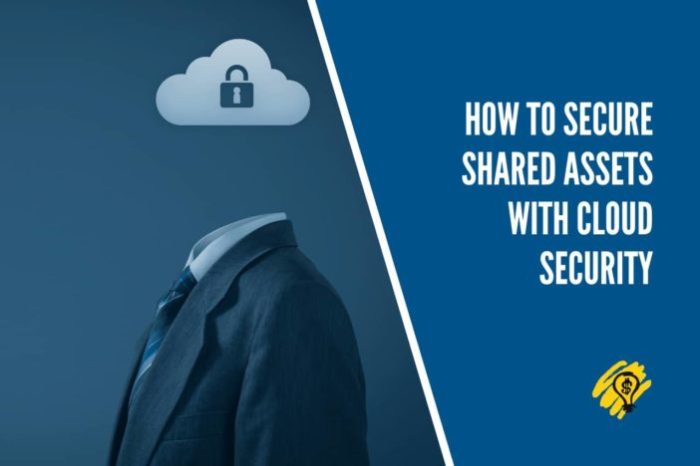When it comes to sharing digital assets securely in the cloud, ensuring the protection of your valuable information is paramount in today's digital age. From safeguarding sensitive data to preventing unauthorized access, the process of securely sharing digital assets is crucial for individuals and businesses alike.
As we delve into the best practices and secure storage options, you'll discover the key components that contribute to a robust cloud-sharing strategy.
Overview of Sharing Digital Assets Securely in the Cloud
Digital assets are any type of content or information that exists in a digital form, such as documents, images, videos, or audio files. In today's digital landscape, these assets play a crucial role in both personal and professional spheres, serving as valuable resources that need to be protected and shared securely.Sharing digital assets in the cloud allows for convenient access from anywhere, at any time, making collaboration and communication more efficient.
However, the importance of securely sharing these assets cannot be overstated. Without proper security measures in place, sensitive information can be exposed to unauthorized users, leading to data breaches and privacy violations.The risks associated with sharing digital assets online include potential data leaks, unauthorized access, malware attacks, and loss of intellectual property.
It is essential to implement encryption, access controls, and secure sharing methods to mitigate these risks and safeguard digital assets in the cloud.Common types of digital assets frequently shared in the cloud include confidential documents, financial records, project files, multimedia content, and software applications.
By understanding the significance of securely sharing digital assets in the cloud and taking proactive security measures, individuals and organizations can protect their valuable information and maintain control over who has access to it.
Best Practices for Securely Sharing Digital Assets
When it comes to sharing digital assets securely in the cloud, following best practices is crucial to protect sensitive information and prevent unauthorized access.
Encryption Methods to Secure Digital Assets
One of the most effective ways to secure digital assets before sharing them in the cloud is by using encryption. Encryption converts the data into a coded format that can only be deciphered with the right key, adding an extra layer of security.
Importance of Using Strong Passwords and Multi-Factor Authentication
Using strong, unique passwords and enabling multi-factor authentication is essential in ensuring the security of shared digital assets. Strong passwords should be complex and not easily guessable, while multi-factor authentication adds an extra verification step, making it harder for unauthorized users to gain access.
Role of Access Control in Ensuring Secure Sharing of Digital Assets
Access control plays a critical role in securely sharing digital assets by limiting who can view, edit, or download the files. By setting permissions and access levels, you can ensure that only authorized individuals have access to sensitive information.
Tips on Regularly Updating Security Measures for Shared Digital Assets
Regularly updating security measures for shared digital assets is key to staying ahead of potential threats. This includes installing software updates, implementing new security protocols, and monitoring access logs for any suspicious activity.
Secure Cloud Storage Options for Sharing Digital Assets
When it comes to securely sharing digital assets in the cloud, choosing the right storage service is crucial. Let's compare popular options like Google Drive, Dropbox, and OneDrive to help you make an informed decision.
Comparing Popular Cloud Storage Services
- Google Drive:
- Pros:
- Offers seamless integration with other Google services.
- Provides generous free storage capacity.
- Cons:
- May raise privacy concerns due to Google's data collection practices.
- Security breaches have been reported in the past.
- Pros:
- Dropbox:
- Pros:
- Known for its user-friendly interface and simplicity.
- Strong focus on security and encryption.
- Cons:
- Limited free storage compared to competitors.
- Higher pricing for additional storage.
- Pros:
- OneDrive:
- Pros:
- Integration with Microsoft Office suite for seamless document editing.
- Offers competitive pricing for storage plans.
- Cons:
- May not be as user-friendly as other options.
- Security concerns have been raised in the past.
- Pros:
Private vs. Public Cloud Storage
- Private Cloud Storage:
- Pros:
- Enhanced control over data privacy and security.
- Customizable security measures based on specific needs.
- Enhanced control over data privacy and security
- Cons:
- Higher costs for maintenance and infrastructure.
- Requires technical expertise to set up and manage.
- Pros:
- Public Cloud Storage:
- Pros:
- Cost-effective with scalable storage options.
- Managed by service providers, reducing maintenance burden.
- Cons:
- Potential security vulnerabilities due to shared infrastructure.
- Less control over data security and compliance.
- Pros:
End-to-End Encryption for Enhanced Security
End-to-end encryption plays a vital role in securing digital assets shared via cloud storage. This encryption method ensures that data is encrypted on the sender's device and only decrypted on the recipient's device, providing a high level of security and privacy.
Choosing the Right Cloud Storage Service
To select the best cloud storage service for securely sharing digital assets, consider factors such as:
- Level of encryption and security measures in place.
- Integration with other tools and services you use.
- Pricing and storage capacity offered.
- Reputation for data privacy and security.
Evaluate these criteria to make an informed decision that aligns with your security needs and preferences.
Collaborative Tools and Features for Securely Sharing Digital Assets

Collaborative tools provided by cloud-based platforms offer a range of features to securely share digital assets with team members. These tools not only facilitate sharing but also provide mechanisms to control access and track changes made to shared files.
Google Workspace
Google Workspace, formerly known as G Suite, includes tools like Google Drive, Docs, Sheets, and Slides that enable teams to collaborate in real-time. Users can set permissions for each file, ensuring only authorized individuals can view or edit specific documents.
Version history allows tracking changes and reverting to older versions if needed.
Microsoft Teams
Microsoft Teams is a unified communication and collaboration platform that integrates with Microsoft Office applications. It offers secure file sharing within channels, chats, and meetings. Teams can control access through permissions, ensuring that sensitive data remains protected. Version control features allow users to see edits made by team members.
Slack
Slack is a popular messaging platform that also supports file sharing and collaboration. Users can share files directly in conversations or channels, with the ability to set restrictions on who can access them. Integration with other tools and services streamlines workflows, making it easier to share and collaborate on digital assets securely.
Real-world Scenarios
In a marketing team, Google Workspace is used to collaboratively create and edit marketing materials, with permissions set to restrict access to confidential campaigns. Microsoft Teams is utilized by a project team to share design documents and track changes made by different team members.
Slack is employed by a tech support team to quickly share troubleshooting guides and solutions with colleagues.
Conclusive Thoughts
By implementing the strategies Artikeld in this guide, you can confidently navigate the realm of sharing digital assets securely in the cloud. Remember, staying informed and proactive is the key to safeguarding your digital information effectively.
Top FAQs
How can I ensure my digital assets are encrypted before sharing them in the cloud?
Utilize encryption tools or services provided by your cloud storage provider to secure your digital assets before sharing them online.
What role does access control play in securely sharing digital assets?
Access control allows you to specify who can view, edit, or share your digital assets, ensuring only authorized individuals have access.
Which cloud storage service offers the best security features for sharing digital assets?
Services like Google Drive and Dropbox are known for their robust security measures, including encryption and multi-factor authentication.






